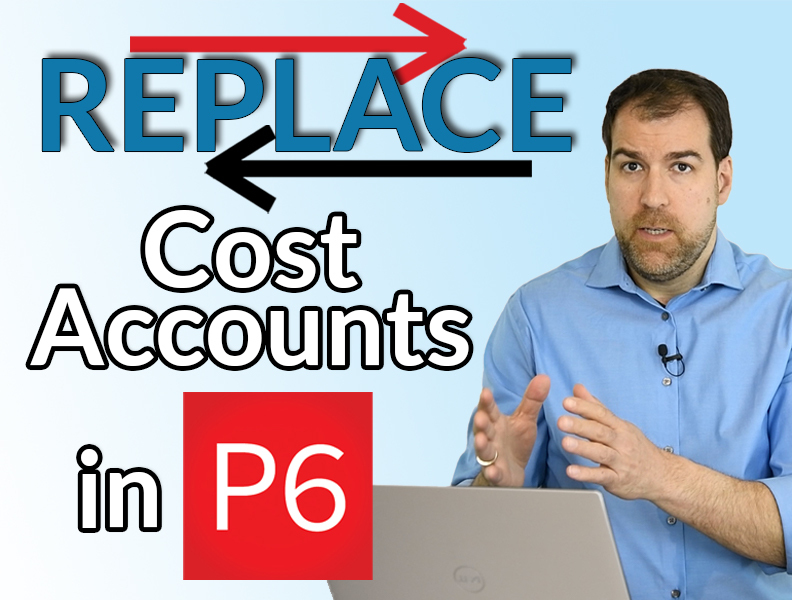Cost accounts: love ‘em, hate ‘em? I’ll tell you what, though: If you’re cost-loading a Primavera P6 schedule, you should be using cost accounts.
Now, chances are good you haven’t yet because they’re hard to use. I get it; they’re really inflexible. They were designed so that you set them up once for a whole database, and you can’t have different versions of them for different projects. Ergo, mega inflexibility.
That’s changed in recent times, though. We have a new construct in Primavera P6 20.12 called the Assignment Code, and it’s a killer tool to put in your arsenal today. Using it, I’ll show you how you can make different versions of cost accounts for different projects to solve the inflexibility problem.
With this new tool, you can make as many groups of cost accounts as you like, each for a different project, and it’s easy to boot.
You ready? Let’s dive in.
How Do We Set Up Primavera P6 Cost Accounts?
In the video, I demonstrate this concept using a project from my Advanced P6 Schedule Building course. We basically assign a cost to every work activity in the schedule, then add them up by cost account. (If you want the details of that, you can check out the course.) The main thing to understand is that every activity has a cost, and when we total all of the costs, they equal the contract value. Of course, I won’t rehas the benefits of cost-loading your P6 schedules – I did that already here.
Now, I also broke out those costs by cost account. Under the Enterprise menu, Cost Accounts, I set up all these different cost accounts so that we can track those and group them into different cost buckets as per the bid. It’s important to group these costs together because they sometimes get charged to the specific expense accounts on the cost side. And that’s what cost accounts do for us.
Once these are all set up, I can go to my Resource Assignments screen and group all resource assignments by cost account, which gives me the breakdown of all the costs in the project by cost account. (Here’s a trick to quickly export this all to Excel)
So, now what? Time for our new Assignment Codes.
Why and How Do You Use Primavera P6 Assignment Codes?
What exactly are Assignment Codes?
Briefly, this is a new feature you’ll find in Primavera P6 version 20.12. It is located on the Enterprise menu, under “Assignment Codes.” Now, when I first saw these, I did complain a bit, I admit.
I mean, don’t we have enough “codes” already, people??
Turns out, however, as soon as I played with Assignment Codes, I realized their immense value.
Here’s how it works. To start, I created a new Assignment Code. I called it “Cost Accounts for the Project-GWP,” the name of my project.
Once I did that, I assigned some of the cost accounts there, using a hierarchy to mimic my cost account structure exactly. It looks a lot like the cost account structure I had initially. (Note that I actually have more than 100 cost accounts, so I didn’t put them all in for the example.) From there, I’m ready to replace resource codes with something much more effective.
Check it out …
How Do You Replace Cost Accounts with Resource Codes?
Time to replace cost accounts with something much easier and more flexible for the long-term. I go to my cost account column, and I start replacing the cost accounts with Assignment Codes. Going down the list, I can assign all of these cost accounts to the new code. This gives me the flexibility I’ve been missing, and I’m betting you’ll notice a huge difference in utility as well.
This also allows you to replace your groupings, which is great. To do that, you go to customize, then group them by the “Cost Account-GWP”, the Assignment Code I set up for this project. Make sure it’s indented properly and the hierarchy is set up here. Once you do that, the grouping works exactly the same way that a cost account group would.
In other words, life just got a whole lot easier.
No longer will you have to fight with cost accounts. Boom: Anytime you need to create a group of cost accounts for a specific project, you can use Assignment Codes instead. That means you do the same amount of work setting up one project, but once you do, you can apply those directly to another project you’re working on. Starting to feel like Primavera P6 Professional is a better bet than you did before? You’re not alone.
Watch the Video and Check Back Soon!
Okay, that’s a wrap this time around. Make sure if you’re confused by any of the directions here in the written portion that you check out the video up top, which should clear things right up.
And also make sure you check out my next video, where I’m going to show you how you can use Excel to import and export Assignment Codes in a P6 EPPM database.

